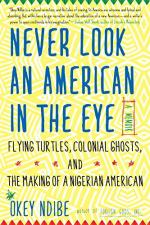|
This section contains 553 words (approx. 2 pages at 400 words per page) |

|
Never Look an American in the Eye: A Memoir of Flying Turtles, Colonial Ghosts, and the Making of a Nigerian American Summary & Study Guide Description
Never Look an American in the Eye: A Memoir of Flying Turtles, Colonial Ghosts, and the Making of a Nigerian American Summary & Study Guide includes comprehensive information and analysis to help you understand the book. This study guide contains the following sections:
This detailed literature summary also contains Quotes and a Free Quiz on Never Look an American in the Eye: A Memoir of Flying Turtles, Colonial Ghosts, and the Making of a Nigerian American by Ndibe, Okey .
The following version of the book was used to create this guide: Ndibe, Okey. Never Look an American in the Eye: Flying Turtles, Colonial Ghosts, and the Making of a Nigerian American. New York: Soho Press, 2016.
The memoir, told through the first-person perspective of its author, Okey Ndibe, begins with a description of his childhood in Nigeria. Raised with little means, he dreams of moving abroad and becoming wealthy. He becomes particularly interested in America due to movies, and his interest matures as a result of the African-American literature he reads in his schooling. Literature plays a crucial part in Ndibe’s intellectual development; he also appreciates Nigerian identity and cultural achievements thanks to the writings of authors like Chinua Achebe.
Ndibe meets Achebe for the first time when interviewing him after becoming a journalist. Later, Achebe offers him the position of founding editor of African Commentary, a new magazine located in Amherst, Massachusetts. Determined to carry out Achebe’s mission of promoting the interest of Nigerians and other Africans abroad, Ndibe moves to America. His first experiences, which involve unprecedented cold weather and racial profiling, are traumatic. However, he settles in and approaches his experiences with Americans with humor and generosity.
Unfortunately, African Commentary collapses after several years due to lack of funds and internecine conflict. A distraught Ndibe is offered his next opportunity from a creative writing professor at the University of Massachusetts, who has admired his journalism and thinks he has the potential to become a novelist. Ndibe enrolls at UMass and works on his first novel, Arrows of Rain. He makes many new American connections in the process, and develops an American immigrant identity while remaining close to his Nigerian background.
In the memoir’s most climactic chapter, Ndibe becomes an American citizen. He notes that many Nigerian and American friends want to know whether he identifies with one culture or the other more strongly, and whether he is less Nigerian now that he has officially become an American. Ndibe challenges their rigid assumptions about culture, describing his dual identity as a “marriage” (143).
Ndibe demonstrates how, as a Nigerian immigrant, he makes valuable cultural contributions to American society, such as sharing folktales with schoolchildren and, of course, sharing his novel with American literary communities. His own experiences in America make him wiser, and he reflects on the life of his late father, Christopher Chidebe Ndibe. Ndibe admires Christopher Chidebe for his gentleness, patience, and nobility, and is intrigued by the lifelong friendship that he carries out with his former commanding officer in World War II, John Tucker. The friendship between John Tucker and Christopher Chidebe is Ndibe’s ultimate model of cross-cultural understanding: in spite of the power differential between them, the two of them willingly conversed on equal footing, and both were personally enriched as a result.
In other ways, Ndibe does not admire his father – at least not at first. Other men in Nigeria often regarded Christopher Chidebe as unmanly because of his devotion to his wife. For a long time, Ndibe internalizes this and is determined to be a lifelong playboy. When Ndibe meets his wife, Sheri, this slowly begins to change. Ndibe concludes his memoir by holding his father up as a model of how to be a loving human being.
Read more from the Study Guide
|
This section contains 553 words (approx. 2 pages at 400 words per page) |

|



